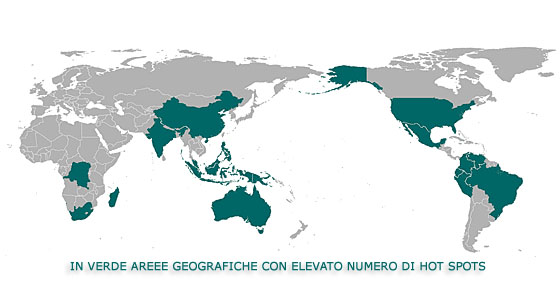|


Gli hotspots di biodiversitÓ (o punti caldi di biodiversitÓ) sono venticinque luoghi sulla faccia della Terra in cui vive la maggior parte della biodiversitÓ.
Per essere qualificato come hotspot un luogo deve avere almeno 1500 vegetali endemici (0,5 del totale planetario) e deve aver subito perdite per almeno il 70% dell'habitat originario.
Nei punti caldi vivono il 44% di tutti i vertebrati terrestri e il 35% di tutte le piante su una superficie pari ad appena l'1,4% di tutte le terre emerse.


"Zinzulusa Cave located 2 km north of Castro Marino (Lecce, Italy) exhibits an exceptionally rich biodiversity with sixty species and subspecies described to date. It is believed that this listing will increase with further exploration. The first pool inside Zinzulusa Cave, La Conca, is characterized by brackish waters and contains both marine and fresh water species. The second pool, Il Cocito, is characterized as oligohaline and shelters a stygobitic fauna including a new stygobitic sponge that has been collected in the deep Cocito. Pollution from urban discharge waters threatens the cave as do tourists who litter and destroy natural formations near the entrance of the cave. The Commune of Castro Marina is currently developing a protection program for the cave in response to the negative impact of tourism. The Department of Environmental Sciences at the University of L'Aquila (Italy), Gruppo Speleologico Salentino "P. de Loretiis" Lecce (Italy), the Castro Commune, and the Alderman Nini Ciccarese have all taken an interest in protecting Zinzulusa Cave" (from: http://karstwaters.org/conduit/vol7no1/karst10.htm#zinzul).
|